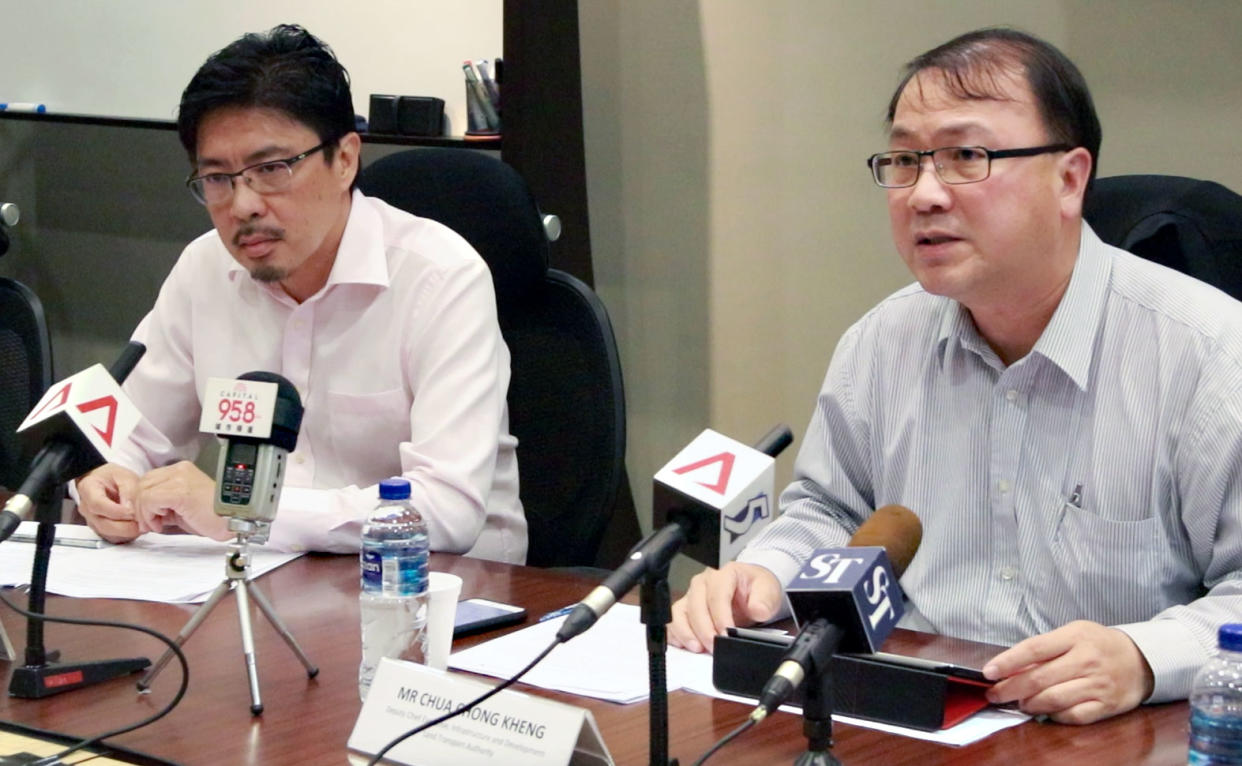Software glitch in signalling system led to Joo Koon train collision

A software glitch in the East-West Line (EWL) signalling system was behind Wednesday (15 November) morning’s collision at Joo Koon station, according to preliminary findings by the Land Transport Authority (LTA), train operator SMRT and French conglomerate Thales.
At about 8.18am, a train heading towards Tuas Link station stopped at Joo Koon station to detrain passengers due to a fault in the train signalling system. At 8.19am, a second train stopped 10.7m behind the first train, in accordance with the existing safety protocol for safe stopping distance between two trains.
A minute late, the first train’s doors closed but before it could move off, the second train was activated by the signalling system and moved forward, hitting the first train at a speed of 16kmh.
The first train was found to have departed Ulu Pandan Depot with a software protection feature but this was removed when it passed by a faulty signalling circuit. As such, when the train arrived at Joo Koon station, its profile on the new Communication-Based Train Control (CBTC) signalling system showed it as a three-car train instead of a six-car train.
Consequently, the second train misjudged the distance between the two, thereby causing the collision.
This information was shared with the media by LTA deputy chief executive Chua Chong Kheng at a press conference held on Wednesday evening at SMRT’s headquarters along North Bridge Road.
Chua emphasised that investigations were still ongoing as to why the software protection feature had been removed.
Checks will be conducted on the whole network that uses the CBTC system, he said, but emphasis would be placed on the EWL, which is undergoing the transition from the older system to the new one.
The EWL currently runs on the older signalling system from Pasir Ris to Pioneer stations, and on the new system from Joo Koon to Tuas Link. As a precautionary measure, all trains will undergo an additional layer of control measures and manual checks before they are deployed.
Operations from Joo Koon to Tuas Link stations will also be suspended for the whole of Thursday (16 November) for Thales, the French conglomerate that is supplying the new signalling system, LTA and SMRT to conduct checks. Bus bridging services will also be deployed for the affected stretch.
Other precautions being taken include reminders to be sent to train captains to be “a lot more vigilant” even if they are driving the trains in automatic mode, said Alvin Kek, SMRT’s senior vice-president for rail operations (North-South East-West Lines).
“Secondly, we have increased the separation of the trains, the distance between the trains travelling on both lines,” he added, referring to both the EWL and North-South Line (NSL). This will result in a lengthened train headway, which refers to the time between trains at stations.
The train headway has been increased from 2 minutes to “2.5 or 3 minutes”, said Kek, who added that the new measure was implemented on Wednesday afternoon.
Signalling systems still operationally safe
Thales has confirmed that the old and new signalling systems continue to be safe for operation, said Chua.
According to Thales representative Peter Tawn, who was also at the conference, the safety distance that the system allows for between trains differs according to the speed at which they are travelling.
“It’s a dynamic signalling system… the slower it goes, the closer they can be together, the faster the trains are travelling, the greater the distance,” Tawn said.
Kek said that while there are systems in place that allow captains to halt the trains in emergency situations, investigations are still being conducted to assess whether the driver of the second train had enough time to react given the short distance between the trains.
There were only 10 seconds between when the second train started moving and when it came into contact with the first train, he noted.
Injured passengers
It was also revealed that the captain of the second train was one of the two SMRT staff injured in the accident, the other being an assistant station manager who had helped to detrain passengers.
All the injured commuters were from the second train while there was no injured in the first train as commuters have detrained from it. In total, 36 people were injured in the accident and have been attended to at the National University Hospital and Ng Teng Fong General Hospital.
Most of the injuries were related to knocks, falls and bruises, with one passenger suffering a broken tooth and another having fainted, Chua said.
When asked about which party should take responsibility for the collision, Chua said, “We are looking to Thales in terms of the solution, and also to convince SMRT and (LTA) that the system is safe… We will work as a team but, primarily, the responsibility for the signalling safety is with the supplier.”
Regarding the safety of the Thales’ system, Tawn said “We’ve never had an incident of this nature. In fact, the CBTC system … has been, I think, on record one of the safest systems. We’ve never had a collision.”
The last such front-to-back train collision took place in August 1993 at Clementi station, which left 156 people injured. In the wake of the accident, an independent inquiry panel was formed to look into the matter and SMRT subsequently revised some of its operating procedures.
Note: This story was updated at 7pm on 16 November 2017 to reflect the latest number of injured persons involved in the collision
Related stories:
28 injured as SMRT trains collide at Joo Koon MRT Station
SMRT tells commuters to add 40 minutes travel time for NSL on Thursday



